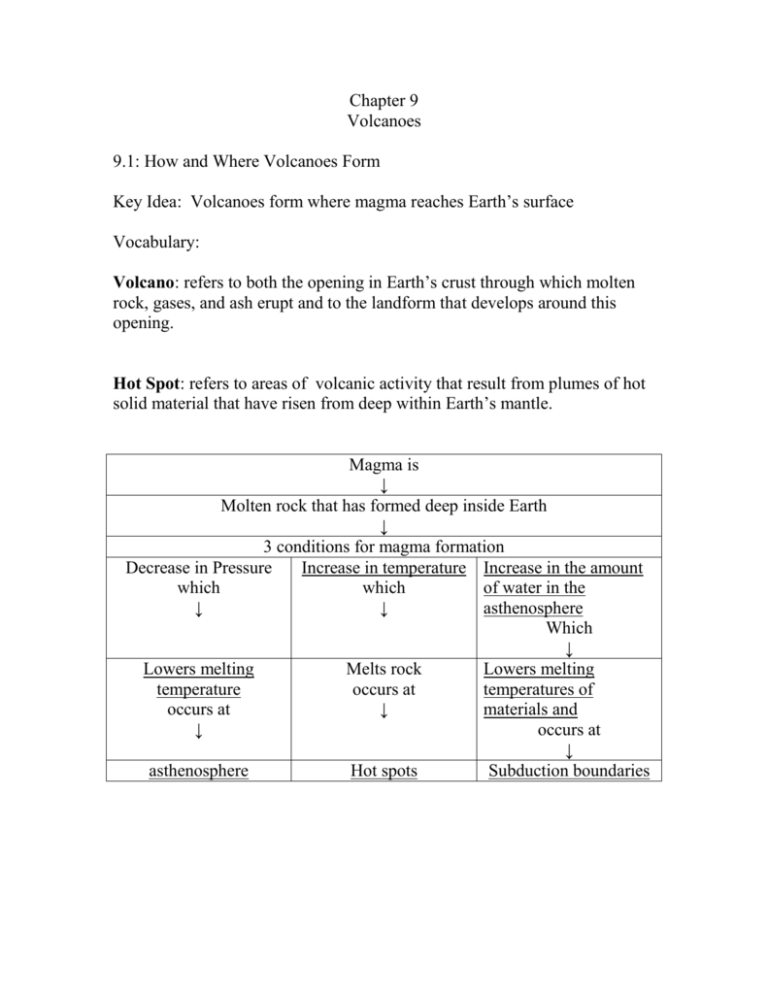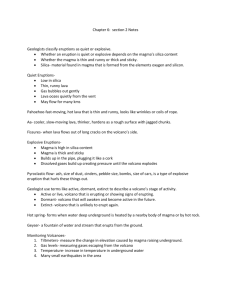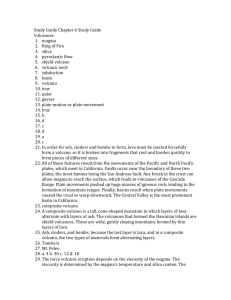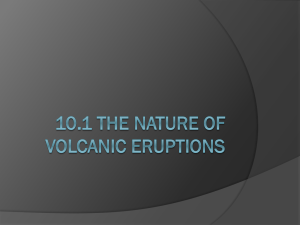Chapter 9
advertisement

Chapter 9 Volcanoes 9.1: How and Where Volcanoes Form Key Idea: Volcanoes form where magma reaches Earth’s surface Vocabulary: Volcano: refers to both the opening in Earth’s crust through which molten rock, gases, and ash erupt and to the landform that develops around this opening. Hot Spot: refers to areas of volcanic activity that result from plumes of hot solid material that have risen from deep within Earth’s mantle. Magma is ↓ Molten rock that has formed deep inside Earth ↓ 3 conditions for magma formation Decrease in Pressure Increase in temperature Increase in the amount which which of water in the ↓ ↓ asthenosphere Which ↓ Lowers melting Melts rock Lowers melting temperature occurs at temperatures of occurs at ↓ materials and ↓ occurs at ↓ asthenosphere Hot spots Subduction boundaries 9.2: Magma and Erupted Materials Key Idea: The composition of magma largely determines how explosive an eruption will be. Vocabulary: Viscosity: A substance’s resistance to flow. Lava: Magma that reaches Earth’s surface Pahoehoe: Solidified basaltic lava flow on land that has formed with smooth, ropelike surfaces. Aa: A solidified basaltic lava flow on land that has formed rough, jagged surfaces. Pyroclastic materials: Solid rock fragments that are ejected during a volcanic eruption. How and why does the silica content of magma affect the explosiveness of an eruption? The higher the silica content, the more explosive the eruption, because more viscous magmas (those with higher silica content) don not allow gases to escape as easily as less-viscous magmas do. Magmas form at rifts, subduction boundaries, and continental hot spots. Which type of magma would you expect to be formed at each location? Rifts: basaltic magma which has the highest melting temperature, the least amount of silica, low gas content, low viscosity, and is rarely explosive. Subduction boundaries: andesitic magma which has a moderate (not high, not low) melting temperature, moderate amount of silica, moderate gas content, moderate viscosity, and is sometimes explosive. Hot Spots: rhyolitic magma which is has the lowest melting temperature, the greatest amount of silica, the highest gas content, high viscosity, and is usually explosive. Melting Temperature Viscosity Silica Content Gas Content Explosiveness Greatest Intermediate Basaltic Andesitic Least Rhyolitic Rhyolitic Rhyolitic Rhyolitic Basaltic Basaltic Basaltic Andesitic Andesitic Andesitic Pahoehoe and Aa are both basaltic. Pahoehoe forms from high-temperature basaltic lava and cools into ropelike surfaces. Aa forms from cooler, slower-moving basaltic lava and cools into rough, jagged surfaces. 9.3: Volcanic Landforms Key Idea: The shape of volcanic landform is determined by the nature of the erupted materials Vocabulary: Shield Volcano: A shield-shaped volcano with a broad base and gently sloping sides that is made of basaltic lava. Cinder Cone: A cone-shaped volcano formed from lava fragments that have been ejected from a volcanic vent. Composite Volcano: A volcano made layers of hardened lava flows and pyroclastic materials. Caldera: A large, crater-shaped basin formed after the top of a volcano collapses. Lava Plateau: A plateau formed from basaltic lava pouring from a crack or fissure in Earth’s surface. Broad base, gently sloping sides Oval base, made of ash and other pyroclastic materials Shield Volcano Formed of layers of materials Cinder Cone A large, crater-shaped basin on top of a volcano Composite Volcano Caldera Lava Plateaus form after a long crack appears in the earth’s surface, and basaltic lava pours up through it and spreads out over the land.








